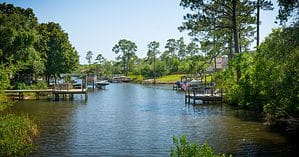There are a ton of places in the United States that are named after animals. Some are regal, such as White Horse, New Jersey. Some are just bizarre. We’re looking at you, Toad Suck, Arkansas. While it is far from an exhaustive list, here are 31 of our favorite places with animal names.
1. Alligator, Mississippi
Located in northwest Mississippi’s Bolivar County, Alligator is a town of 116 residents per the 2020 census. The town’s name came from Alligator Lake, a body of water in the town that held a prodigious number of alligators in the past. Mississippi has the seventh-highest population of alligators among U.S. states.
When addressing mail to Alligator (the zip code is 38720, if you were wondering), astute observers may notice that “Alligator, Mississippi” is very close to the scientific name of the American alligator: Alligator mississippiensis. And if you didn’t notice that before, you’re sure to notice it from now on!
2. Big Bear Lake, California
Located in San Bernardino County, Big Bear Lake has a population of 5,046 per the 2020 census. However, it is a wildly popular resort area, so it is common for that quaint population to multiply twenty times or more on weekends and holidays.
The name of both the city and the wider region dates back to the mid-1800s. In 1845, Benjamin Davis Wilson led a posse of 20 men into the valley to hunt down the raiders who had been terrorizing their ranches. When they entered the valley, they found it teeming with grizzly bears. These “big bears” led to the name we use today.
People didn’t build the body of water known as Big Bear Lake until well after Wilson’s mission. In 1884, workers constructed the first dam, and in 1911, they built the current dam.
Big Bear Lake was also the site that launched Southern California’s gold rush. In 1860, William Holcomb was hunting bears (because it is the home of big bears, after all) when he found some gold flecks in a creek. Try as he might, he was not able to keep his discovery a secret and the area soon flooded with prospectors.
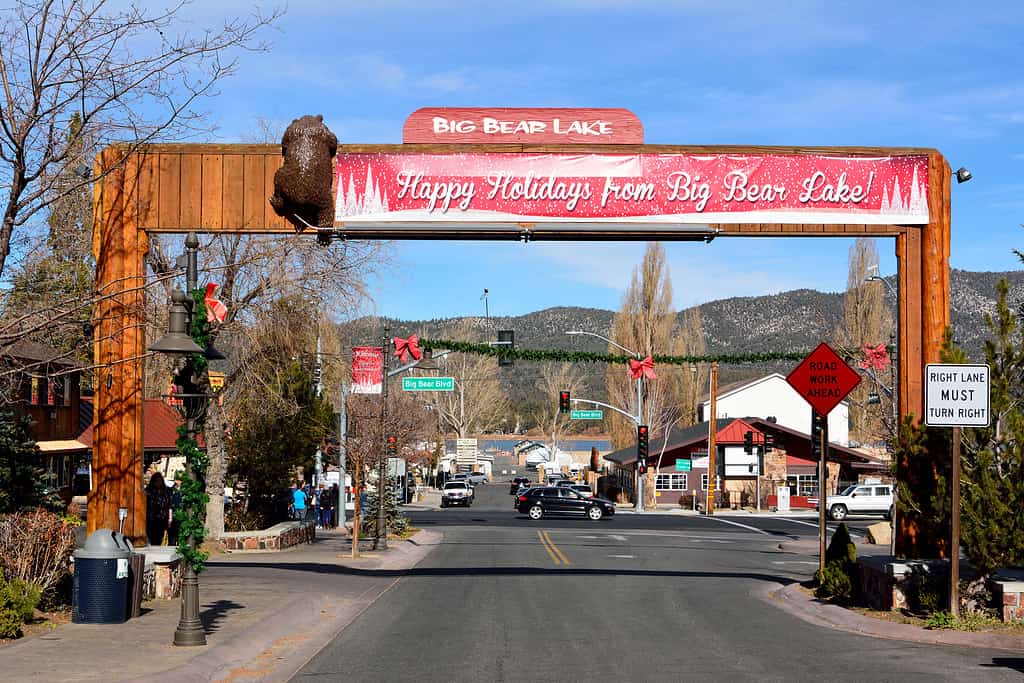
Big Bear Lake welcomes visitors all year long.
©iStock.com/AlizadaStudios
3. Bivalve, Maryland
This tiny town is located in Wicomico County along the eastern shore of the lower Nanticoke River, near its mouth on the Chesapeake Bay. Bivalve takes its name from the oyster that was once the economic foundation of the town. Bivalve had a population of 122 in the 2020 census.
Maryland residents may take up to 100 oysters a day recreationally. The state reached a 35-year high in 2022 when about 511,000 bushels of oysters were collected commercially.
4. Buffalo, New York
There are few animal-named towns more well-known than Buffalo, New York. It is famous for its pro sports teams (the Bills and the Sabres), Niagara Falls, and, of course, its Buffalo Wings.
Buffalo’s name likely derives from Buffalo Creek, now called the Buffalo River. While there are many theories, the source of the river’s name is unknown. The American bison’s historic range did stretch into western New York, so it is at least plausible that this gave rise to the name.
New York certainly has the most famous town named Buffalo, but it is not alone in housing a town with the name. Illinois, Oklahoma, and Wyoming also have towns named Buffalo.
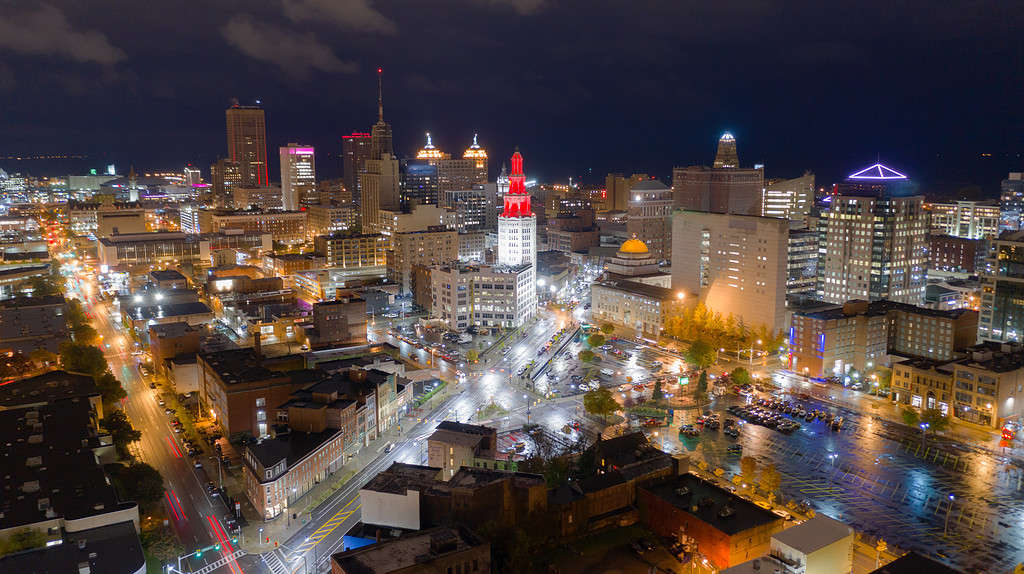
Buffalo is one of the largest cities in the U.S. with an animal name!
©iStock.com/ChrisBoswell
5. Bullfrog, Utah
This amphibian-named Utah town is located in the Glen Canyon National Recreation Area. There is a National Park Service visitor center in Bullfrog. No one is quite sure how Bullfrog got its name. Bullfrog Creek is nearby, though it became Bullfrog Bay after the creation of Lake Powell. But again, the name itself is a mystery.
Bullfrogs are native to (roughly) the eastern two-thirds of the United States. They are not native to Utah and are an invasive species in the state.
6. Bumble Bee, Arizona
This town was founded in 1864 as a stagecoach stop and a position for the U.S. Calvary. The name came from the numbers of indigenous people that early travelers claimed were as “thick as bumblebees.” The town grew large enough to warrant a post office in 1879, but dwindled as stagecoach use was abandoned in favor of new, more efficient modes of transportation.
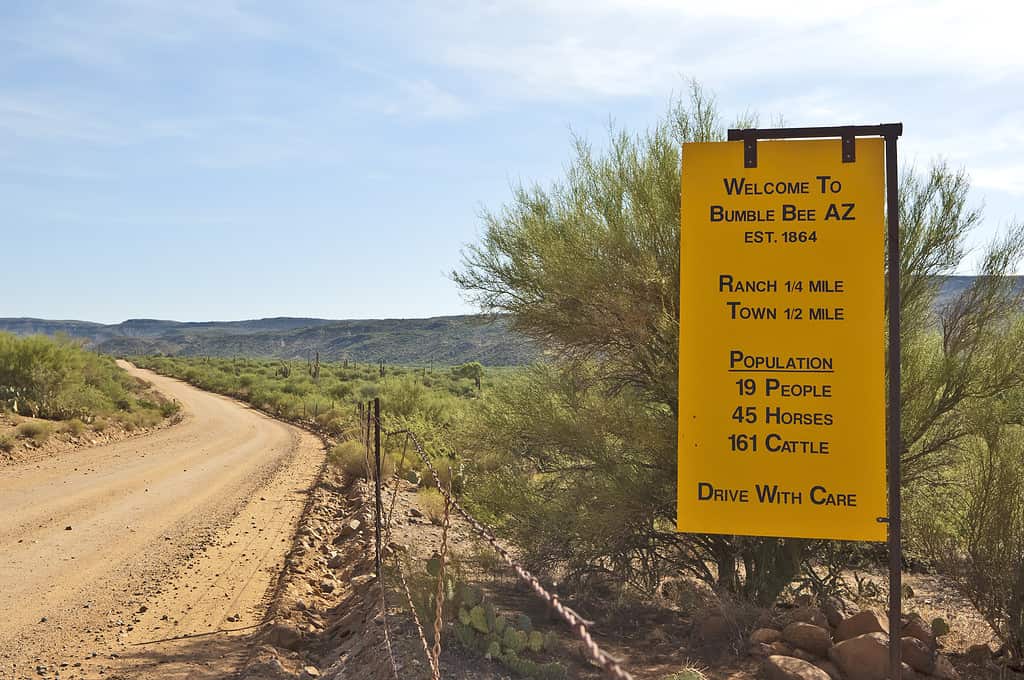
There are far more cows than people in Bumble Bee!
©Structured Vision/Shutterstock.com
7. Caribou, Maine
Less than ten miles from the Canadian border, Caribou advertises itself as The Most Northeastern City in the United States. Caribou’s beginnings date to the early 1800s when loggers and trappers set up camps in the area. The first settlers arrived in what would become Caribou in the 1820s. The town was incorporated in 1859, although it was known as Lyndon at the time. The name would be changed to Caribou in 1877 in honor of the woodland caribou that were once found throughout the region.
Caribou was home to 7,396 residents per the 2020 census. It is a gateway community to Maine’s Great North Woods and is also home to a National Weather Service office. The city is famous for its heavy snow. Caribou receives over 118 inches of snow in an average season.
8. Carp, Nevada
Hardly anything is left of the town of Carp in Lincoln County. The town was born as a stop on the Union Pacific Railroad. It received a post office on June 29, 1918, but the town was then known as Carpsdale. That name was rescinded and the town became known as Cliffsdale in 1921. Then, the local postmaster, Tom Casey, changed the name once again. The town became known as Carp on December 1, 1925.
The town was not named after the fish, but rather after a railroad agent named Carp. The post office in Carp remained open to serve remote Nevada ranchers until July 1, 1974.
Carp (the fish, not the railroad dude) are native to Asia and Europe, but they have been stocked throughout the United States. They are found in rivers, reservoirs, lakes, and ponds throughout Nevada. The biggest carp ever caught in Nevada weighed over 35 pounds.
9. Chicken, Alaska
Located in eastern Alaska just 28 miles from the Alaska/Canada border, the town of Chicken was an Alaskan gold rush town. It was named after the ptarmigan, a game bird that proliferates in the area. Chicken had a population of 12 in the 2020 census, making it Alaska’s 319th most-populous town out of a total of 332 towns. The population grew from just seven in the 2010 census. Don’t scoff. That is over 71% growth in just ten years!
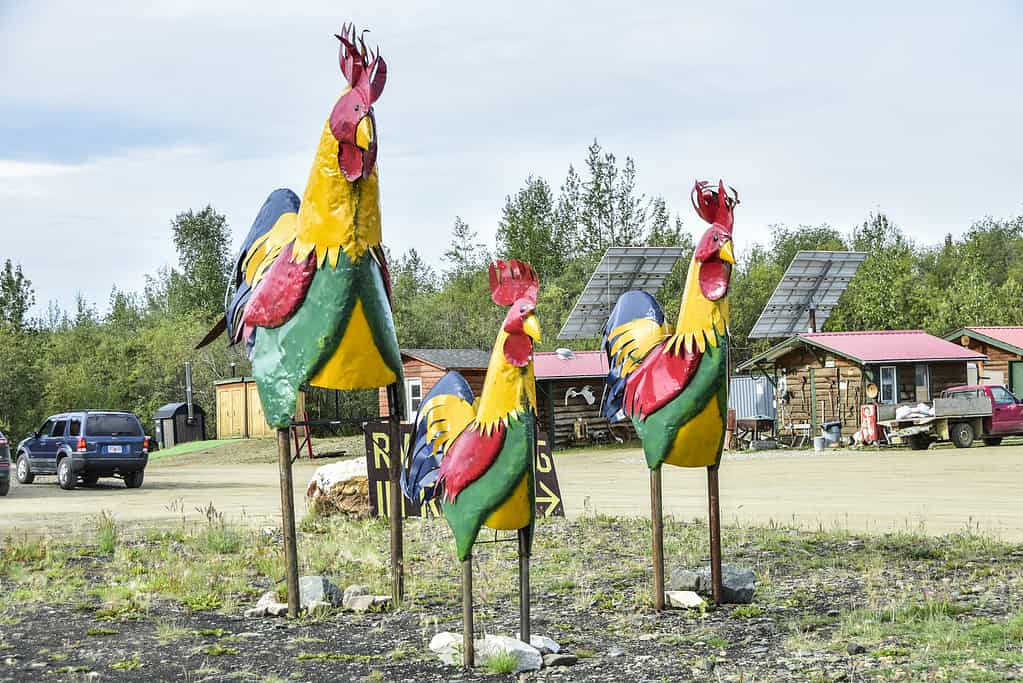
Colorful chicken sculptures greet visitors as they enter the very small town of Chicken, Alaska.
©iStock.com/Lisa Kedian Photography
10. Cougar, Washington
Located in Cowlitz County in southwest Washington, Cougar’s population was 93 in the 2020 census. Cougar is the closest community to Mount St. Helens. The eruption of Mount St. Helens on May 18, 1980, killed 575 people, making it the deadliest volcanic event in U.S. history.
Cougar was named after the cougar, of course. Other names for the big cat include mountain lion, puma, panther, and catamount. There are an estimated 1,500 cougars in Washington State.
This small Washington town named after the cat was the original Cougar Town, long before the TV series came along!
11. Coyote, New Mexico
If the zip code 87012 sounds familiar, then maybe you have been to Coyote, New Mexico. There were 71 people who made their home in this tiny northern New Mexico town per the 2020 census.
The village, located in Rio Arriba County, was named after Coyote Canyon. The canyon, presumably, was so named because of the large number of coyotes that could be heard howling during the night.
The town’s roots date back to the San Juaquin Land grant, given by the King of Spain in the early 1800s. But because of clashes with indigenous people, the town was sparsely populated and then essentially abandoned. Homesteaders returned after indigenous tribes were forcibly removed, at least partially through Kit Carson’s Long Walk.
12. Dinosaur, Colorado
Originally known as Artesia, this town in northwestern Colorado’s Moffat County changed its name to Dinosaur in 1966. The visitor center and the Colorado entrance to the Dinosaur National Monument are just two miles from this little town.
Hiking, camping, and rafting are all available in the confines of the national monument. The star of the show, though, is the multitude of dinosaur tracks and fossils.
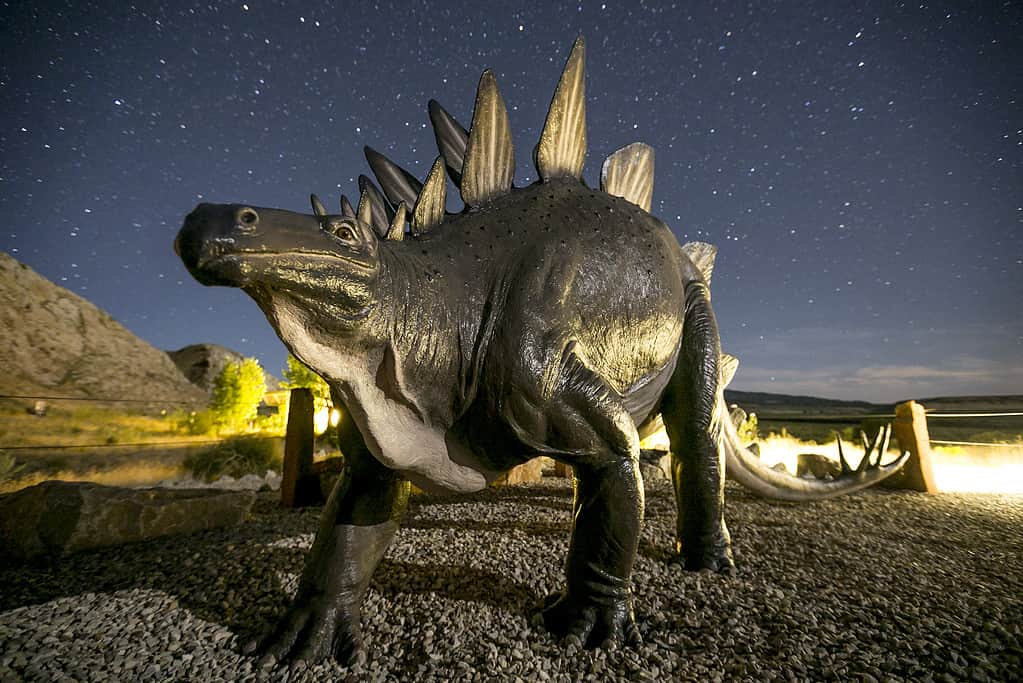
This statue of a Stegosaurus stands at Dinosaur National Monument.
©National Park Service / Public domain – License
13. Duck, North Carolina
This resort town in the Outer Banks has a population of 747 per the 2020 census, but you would never believe that if you visit during the summer. This town can house upwards of 20,000 vacationers during the peak season.
Duck is located in Dare County, the easternmost county in North Carolina. This coastal town was named for, you guessed it, ducks. The name was chosen to honor the many ducks and other waterbirds of the region. The town in the Outer Banks is also a midway point on the Atlantic flyway for migratory ducks as they make their way between the Arctic and the tropics.
The town’s incorporation was quite recent. Duck was incorporated on May 1, 2002, making it the sixth incorporated town in Dare County.
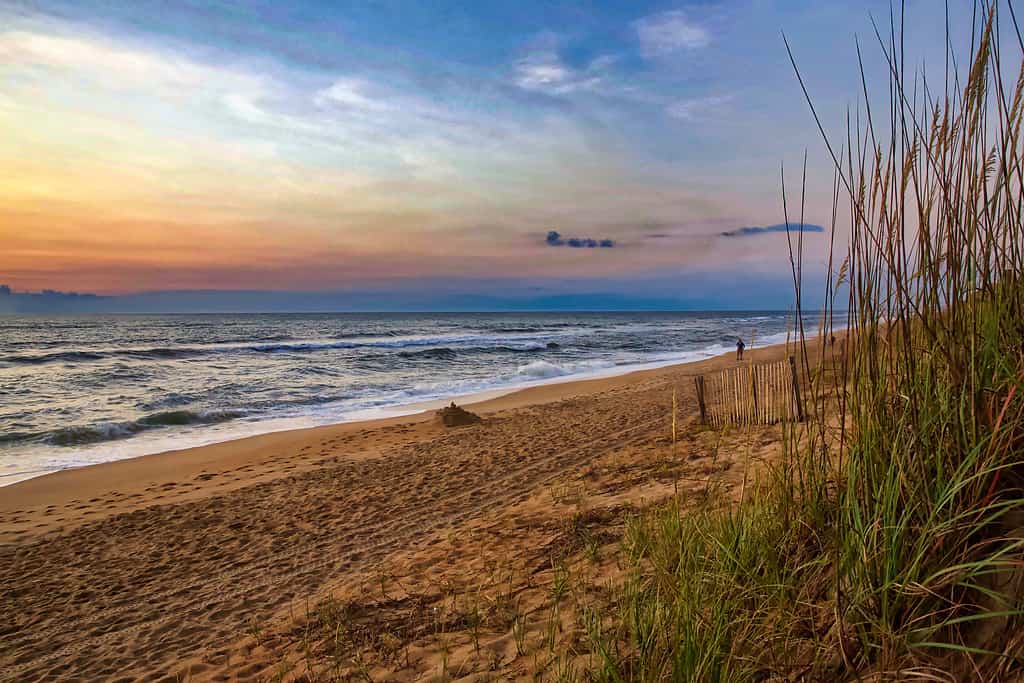
Sunrise on the picturesque shore of Duck is the definition of serenity.
©Jeremy Tyree/Shutterstock.com
14. Eagle, Nebraska
Located in Cass County, Eagle sits 14 miles east of Lincoln. It was originally settled in 1896 when construction of the Missouri Pacific Railroad reached that point.
The town may have been called Sunlight initially, but Eagle was the name that stuck. It likely came from the number of eagles sighted by the town’s first residents. Bald eagles and golden eagles are both native to Nebraska.
There are also towns named “Eagle” in Alaska, Colorado, Idaho, Michigan, and Wisconsin.
15. Elkhart, Indiana
This northern Indiana city is home to 53,923 per the 2020 census. It is located in Elkhart County and is known as the RV Capital of the World. It is estimated that one out of every two RVs on the road today were manufactured in Elkhart. Dutchman, Forest River, Jayco, Keystone, and many other major RV manufacturers are based in Elkhart.
According to Michael McCafferty, the city’s name is a combined form of the words “Elk’s heart.” It was named after the now-extinct Eastern elk that one proliferated the region.
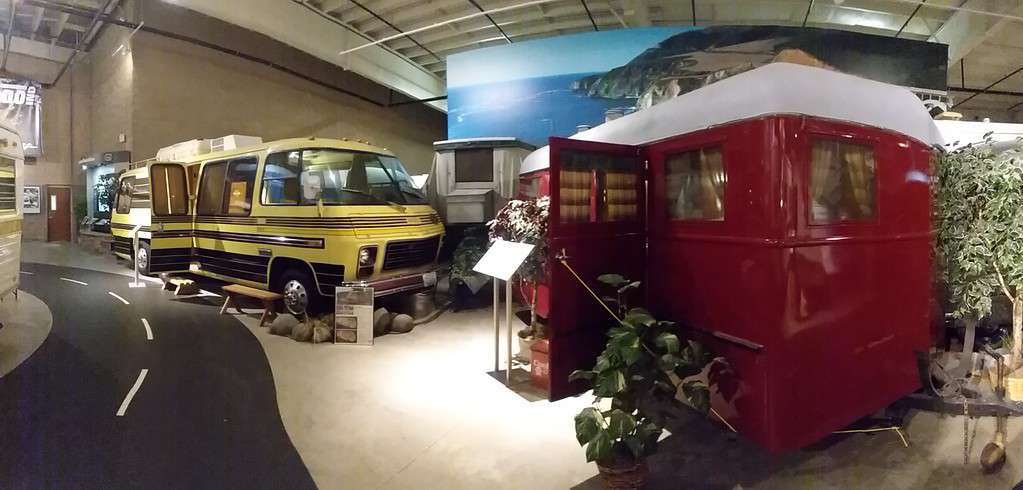
Elkhart, the RV Capital of the World, is home to the RV Hall of Fame.
©Chris Light / CC BY-SA 4.0 – License
16. Flamingo, Florida
This Monroe County town is the southernmost headquarters for Everglades National Park. The history of the town dates back to the Tequesta Indians. Settlers first arrived in 1892. The following year, those settlers had to choose a name so a post office could begin operation. They chose Flamingo, named after the distinctive pink wading birds. The post office would close just 16 years later in 1909.
Flamingos once proliferated the Everglades area, but habitat destruction, hunting, and egg-collecting severely damaged their numbers. Today, while the flamingo population is nowhere near its historic level, flamingos have returned to Florida and to the Everglades.
17. Fly, Ohio
The little river town of Fly, Ohio sits along the Ohio River on Ohio/West Virginia border. The village in Monroe County received a post office in 1886. The post office remained in operation until 1995.
It seems that the town’s name had nothing to do with the pesky insect that we all know and loathe. Rather, according to William Daniel Overman, the town’s residents chose the name because it was short and easy to spell. They claimed it was the shortest town name in all of Ohio, although that wasn’t true. Ai in Fulton County had the shortest name of any Ohio town. Along with the shorter name, Ai was shorter-lived than Fly. Ai’s post office opened in 1846 and was shuttered in 1903.
18. Killdeer, North Dakota
Killdeer is located in Dunn County in west-central North Dakota. It was founded in 1914 as a stop along the Northern Pacific Railway. The town had 939 residents according to the 2020 census.
Killdeer was named for the Killdeer Mountains. While killdeer is the name of a plover, the mountains were not named for the bird. Instead, the mountain range was so named because it was an ancient hunting ground where Native Americans would “kill deer“.
19. Kitty Hawk, North Carolina
This town of 3,708 (2020 census) in Dare County was made famous by the Wright Brothers. The brothers made the world’s first controlled powered airplane flights on December 17, 1903 at Kill Devil Hills, just four miles south of Kitty Hawk.
Some suggest the name of this famed town is derived from crane flies, sometimes called mosquito hawks. However, the more accepted origin story comes from the Algonquin-speaking tribes that inhabited the area long before European settlers arrived. They referred to the area as “Chickenhauk,” which means “a place to hunt geese.” It is believed that Kitty Hawk is an Anglicized form of that Algonquin name.
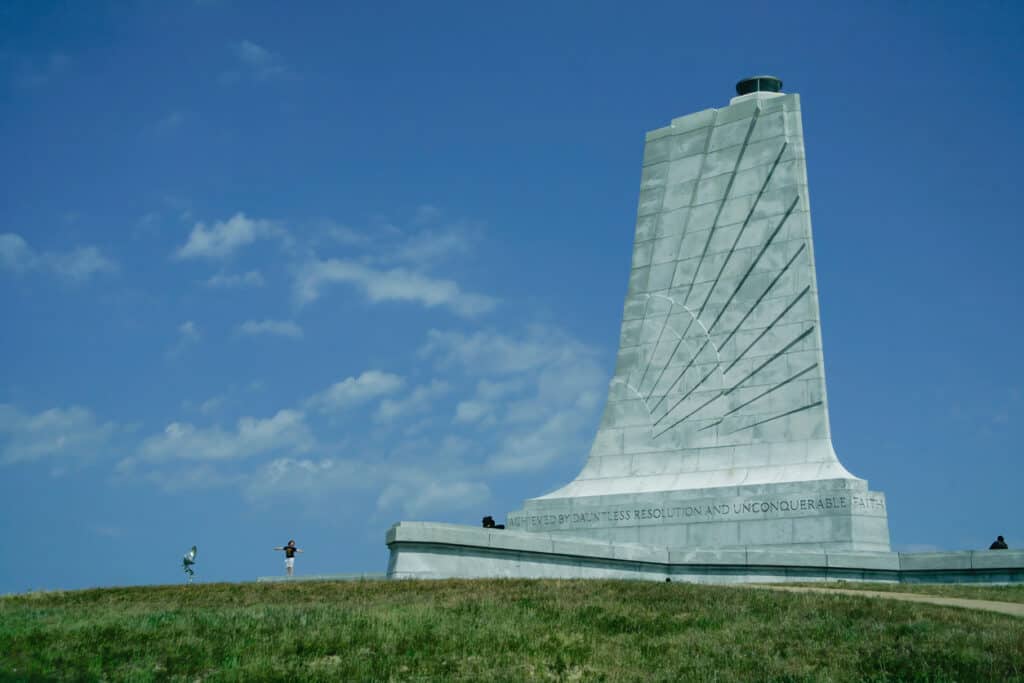
The Wright Brothers Monument celebrates the first successful airplane flights in 1903.
©iStock.com/imagewerks
20. Lame Deer, Montana
The 2020 census reported a population of 1,897 in Lame Deer. The small town is part of the Northern Cheyenne Indian Reservation in Rosebud County. The town is named after the Miniconjou Lakota chief, Lame Deer. The chief also had a second name: “The Elk that Whistles Running.” Chief Lame Deer was killed just south of town by the U.S. Army in 1877. He was killed under a flag of truce.
The town of Lame Deer is where the Northern Cheyenne Indian Reservation’s tribal and governement agency headquarters are located. It is also the home of the Northern Cheyenne Powow and Chief Dull Knife College.
21. Monkey’s Eyebrow, Kentucky
This little community with a supremely odd name is located in Ballard County in extreme western Kentucky. While no one is certain how the town was given this weird moniker, the most prominent theory is that, when viewed from the air, Ballard County looks a bit like a monkey’s head. The town of Monkey’s Eyebrow is located where the eyebrows would be on the monkey. It has also been suggested that, from the top of a nearby hill, the town itself looks like a monkey’s eyebrow.
However, there is a problem with these theories and the town’s name. Monkeys don’t have eyebrows. While all primates have a brow ridge (the bony ridge located above the eye sockets), only humans have a strip of isolated hair known as eyebrows.
22. Pigeon Forge, Tennessee
This city in Sevier County draws ten million visitors each year. It boasts restaurants, stores, and tourist attractions galore, including the world-famous Dollywood, owned by country music legend Dolly Parton. Pigeon Forge also sits on the border of the Great Smoky Mountains National Park, the most-visited national park in the nation.
The “Pigeon” part of the town’s name comes from Little Pigeon River. The West Prong of the river flows directly through Pigeon Forge. The river got its name from the multitudes of passenger pigeons that once roosted along its banks.
The “Forge” moniker came from an iron forge built in 1817 by Isaac Love. The forge was built near where the iconic Old Mill stands today.
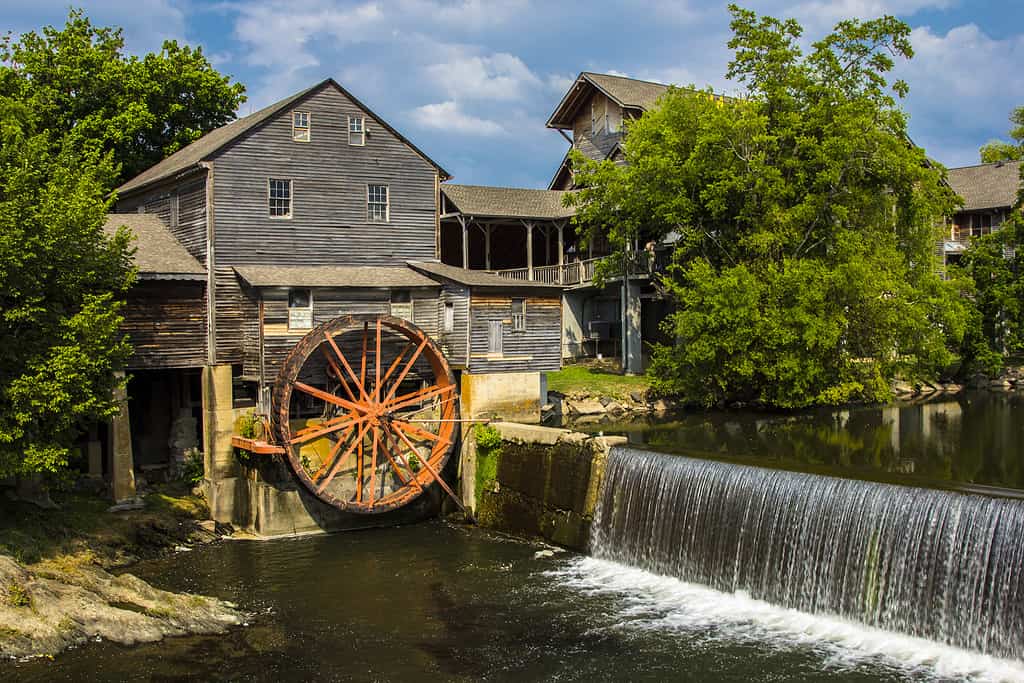
The Old Mill is a historic gristmill in the heart of Pigeon Forge.
©Scott Prokop/Shutterstock.com
23. Porcupine, South Dakota
There are 925 people who call Porcupine home, according to the 2020 census. The town is in Oglala Lakota County in southwestern South Dakota. Porcupine got its name from Porcupine Butte, a mountain summit found on the Pine Ridge Indian Reservation. The summit was named for the prickly pine trees growing on the mountain peak, resembling the quills of a porcupine.
Porcupine is home to the first American Indian-owned radio station in the United States. KILI was founded in 1983 as a non-profit station dedicated to broadcasting to the Lakota people living on the Pine Ridge, Cheyenne River, and Rosebud Indian Reservations.
Interestingly, there is also a Porcupine town in North Dakota.
24. Rabbit Hash, Kentucky
This little hamlet is on the National Register of Historic Places. It is located in Boone County, the most northern-reaching county in the state. Its position on the Ohio River would also give the town its name, at least according to local legend.
As the story goes, a flooded Ohio River sent the area’s many rabbits to higher ground. That made them easy targets for the local populace, many of whom cooked the rabbit meat in a hash recipe.
We know very little about the history of Rabbit Hash, other than its many floods. Ohio River floods in 1884, 1913, and 1937 were devastating for the small town. The river reached a record 79.9 feet in Rabbit Hash in 1937. The Rabbit Hash General Store, which is in operation to this day, still has mud from the 1937 flood in its attic!
This quirky little town gained national attention in 1998 when it held a mayoral “election.” In reality, it was a fundraiser to restore a local historic church building. Each vote cost one dollar. The winner of the election? A dog named Goofy Borneman! The town has had a string of canine “mayors” ever since. The current mayor is a French bulldog named Wilbur.
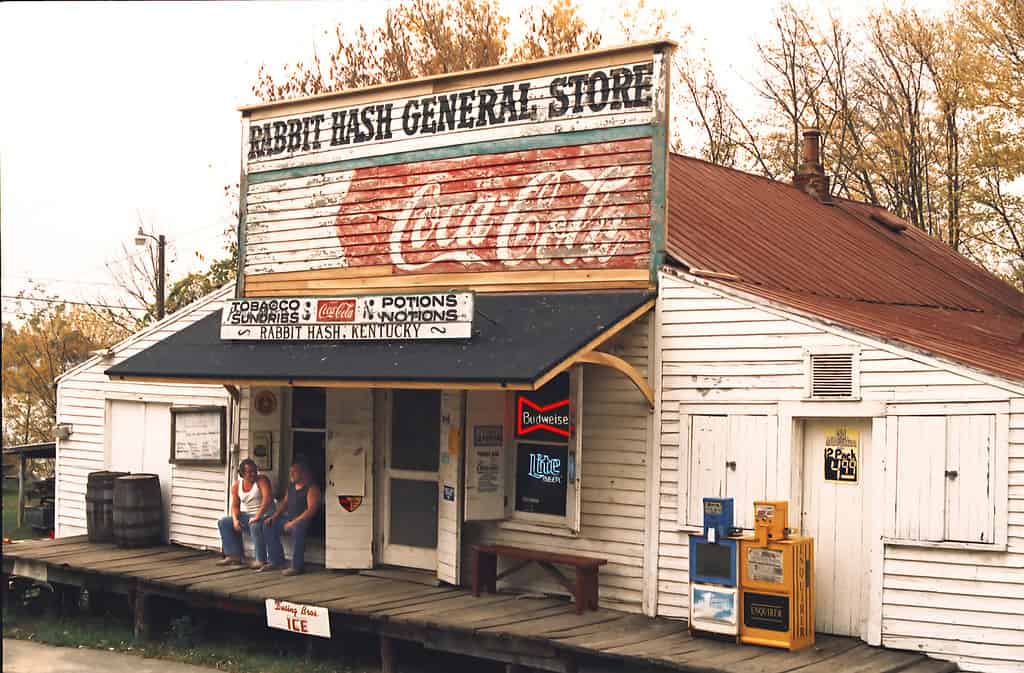
The Rabbit Hash General Store is still in operation today.
©FloridaStock/Shutterstock.com
25. Rattlesnake, Florida
Now located in Tampa, Rattlesnake was founded in the 1930s. The area was teeming with eastern diamondback rattlesnakes. George End had moved to Florida from Wisconsin but failed to find success as a farmer. He did, however, discover that the meat of the rattlesnakes that surrounded his home was quite tasty. He opened a cannery to produce canned rattlesnake meat, or “SnakeSnaks.” At its peak, End’s company was shipping out 15,000 cans per year. However, in 1944 one of End’s rattlesnakes bit him. He died within hours, and his wife shuttered the plant. Tampa annexed the Rattlesnake area in the 1950s.
26. Tiger, Georgia
Rabun County, the northeasternmost county in Georgia, is home to a little town called Tiger. The 2020 census reported 574 Tiger residents.
There are a couple of theories regarding the town’s naming process. One suggests that it received its name in honor of Tiger Tail, a Cherokee chief. The other explanation is the town was named for the haunting cries of panthers in the area. Yes, panthers and tigers are two different cats, but they didn’t ask us before naming the town.
The town sits just a few miles from Georgia’s borders with both North and South Carolina. It lies in the shadow of Tiger Mountain, a prominent peak in the Blue Ridge Mountains that reaches 2,856 feet of elevation.
27. Toad Suck, Arkansas
No, we didn’t make this one up. Toad Suck is a little unincorporated town in central Arkansas’ Perry County.
The true origin of the town’s strange name is unknown. Some theorize that it is a corruption of a French word or phrase. They suggest the term “chute” since it refers to a narrow water passage and since the town is located on the Arkansas River.
Others claim the name was born when rivermen would stop at local taverns and “suck on the bottle ’til they swelled up like toads.”
Either way, it doesn’t seem like the town’s name has anything to do with the 23 different species of toads and frogs native to Arkansas.
There is a local park in the area with the name Toad Suck Park. There is also an annual festival in the neighboring town of Conway called Toad Suck Daze.
In 2012, Find My Past surveyed users in multiple English-speaking countries, asking them to vote on the “most embarrassing or unfortunate town name” in the United States. The winner? Toad Suck, Arkansas.
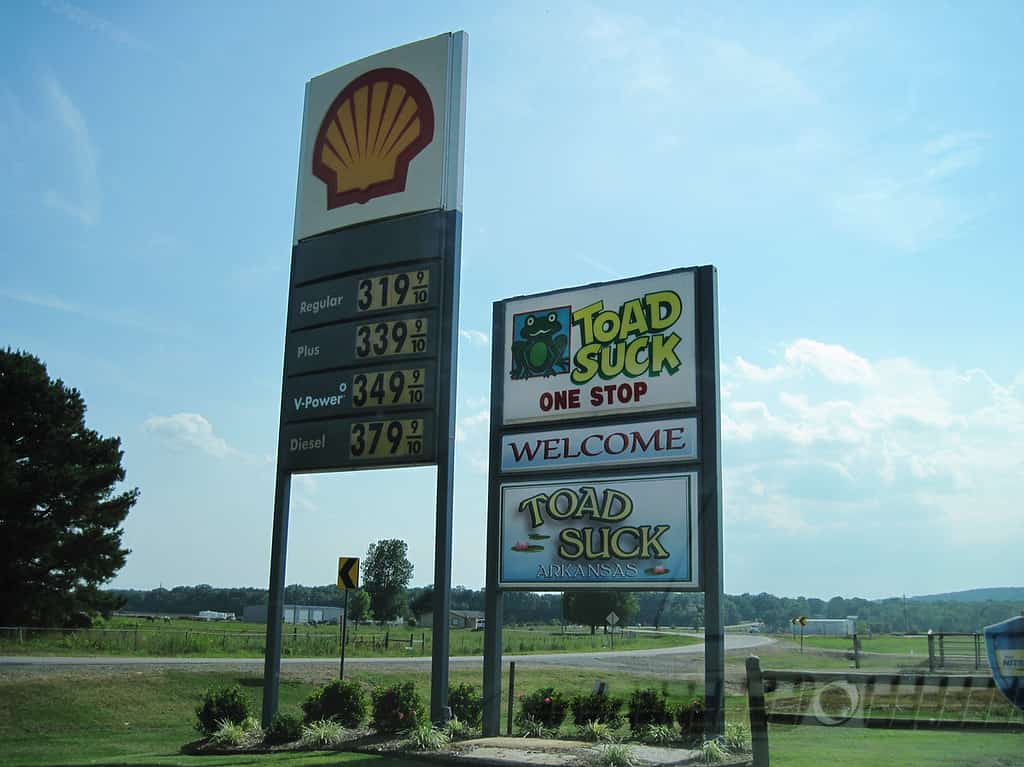
The gas station welcomes drivers to Toad Suck, Arkansas.
©formulanone from Huntsville, United States / CC BY-SA 2.0 – License
28. Turkey, Texas
Turkey is located in Hall County in the Texas Panhandle. It boasted a population of 317 in the 2020 census. It is also the hometown of the late Bob Wills, the “King of Western Swing.” Wills was a pioneer of Western swing music and one of the greatest influences in country music history. Waylon Jennings wrote a song in the mid-1970s entitled “Bob Wills is Still the King.”
The town of Turkey dates back to the late 1800s. In 1893, the town opened a post office, but it was hardly a conventional building. It was, instead, a dugout nestled into the banks of a creek. Given its unique location, wild turkeys found it a suitable place to roost, leading to the town earning the name ‘Turkey Roost.’ However, when the post office eventually found a home in a proper structure, they simplified the town’s name to ‘Turkey.’
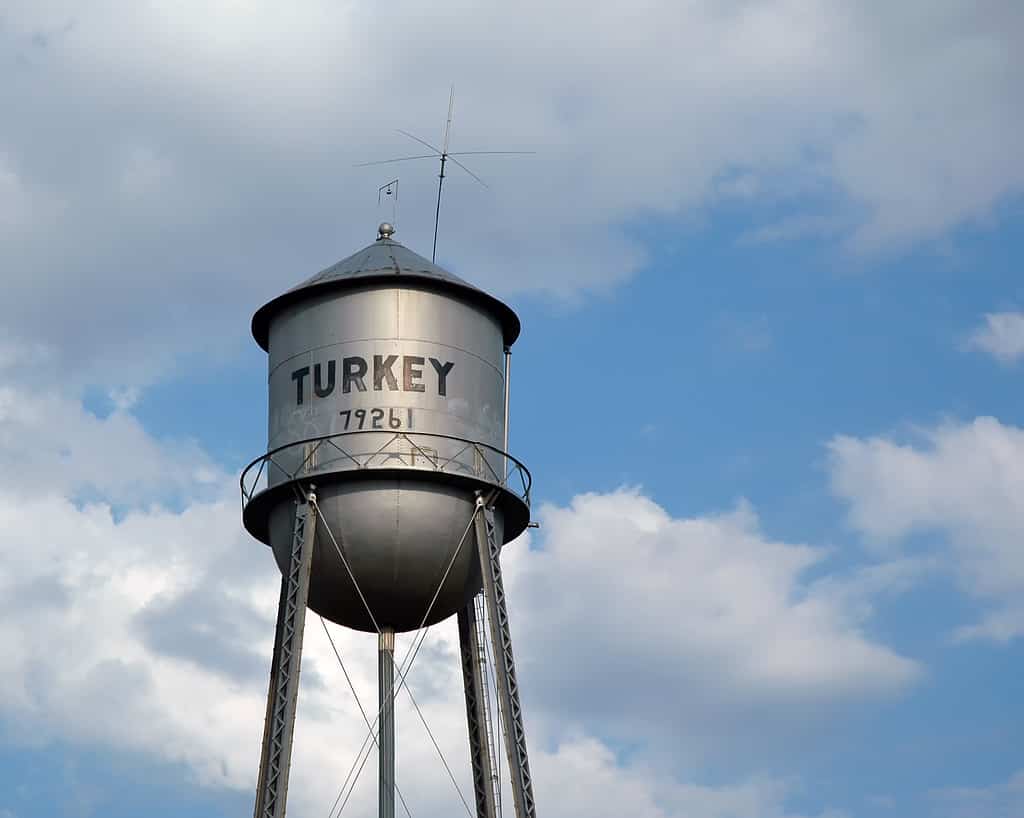
A Tin Man Style Water Tower welcomes visitors to Turkey, Texas.
©xradiophotog/Shutterstock.com
29. Turtle, Missouri
This small Missouri town was located in Dent County in the south-central part of the state. The town received a post office in 1905, which remained in operation until 1954. The town folded in the mid-1950s. It received its name from Turtle Pond, a small body of water in the area that teemed with turtles.
There are 16 turtle species native to Missouri, including hard-shelled and soft-shelled aquatic turtles and hard-shelled land turtles. The three-toed box turtle is Missouri’s state reptile.
30. White Horse, New Jersey
This town in Mercer County was home to 9,710 people in 2020. White Horse draws its name from a tradition that claims George Washington rode through the region on a white horse in 1789. He was reportedly on his way from Virginia to New York City for his first presidential inauguration.
In 2010, to commemorate the tradition that bequeathed the town its equestrian name, builders erected a 10-foot statue of a white horse in White Horse Circle, the town’s traffic circle.
31. Wolf Point, Montana
Located in northeast Montana, Wolf Point is the county seat of Roosevelt County. It is also the Fort Peck Indian Reservation’s largest community.
As with many towns with animal-themed names, no one is completely certain of its origin. The prevailing theory suggests that William Bent, nephew of Kit Carson, came up with the name after hunting wolves in the area during the winter of 1868-1869. According to legend, so many wolves were hunted that their bodies were stacked up like wood until the spring.
The town’s origins date to the 1860s when a trading post opened at Wolf Creek and the Missouri River. The Great Northern Railway’s arrival in 1887 led to a population expansion. The town was incorporated in 1915.
The 2020 census record 2,602 residents of Wolf Point. The town is home to Wadopana Powwow each August. It also hosts the Wild Horse Stampede, Montana’s oldest rodeo, every July.
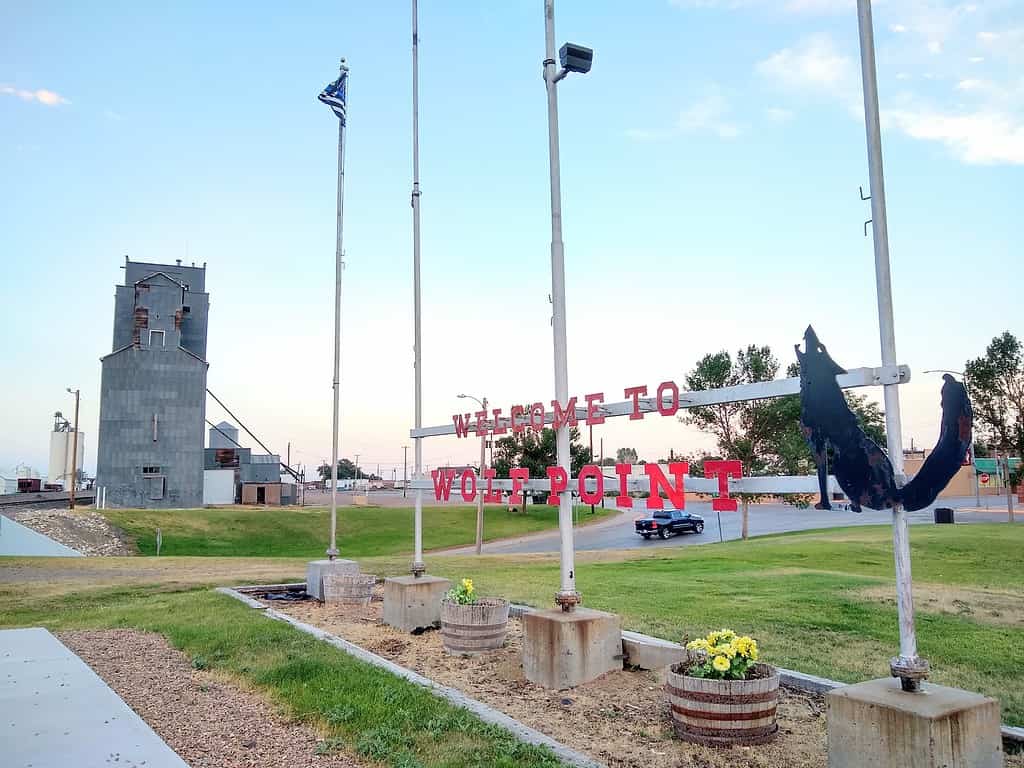
This sign welcomes visitors to Wolf Point, Montana.
©Thayne Tuason / CC BY-SA 4.0 – License
The photo featured at the top of this post is © xradiophotog/Shutterstock.com
Thank you for reading! Have some feedback for us? Contact the AZ Animals editorial team.






